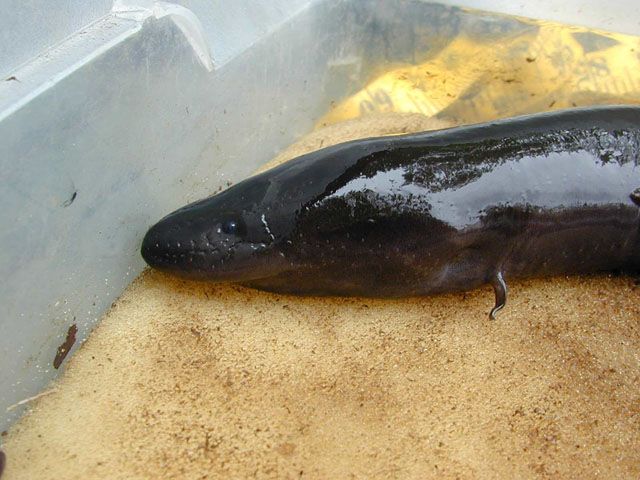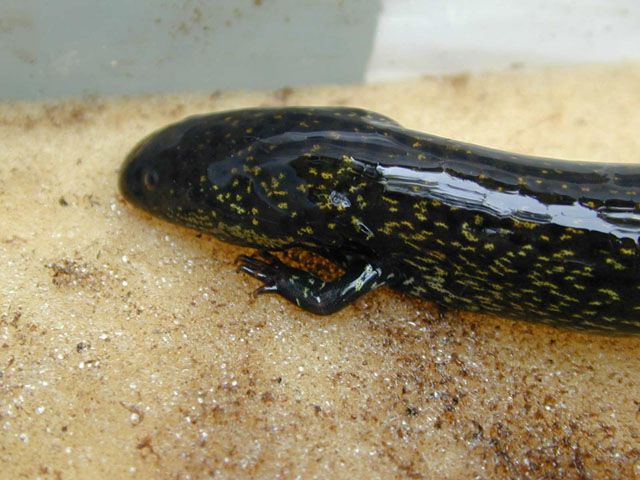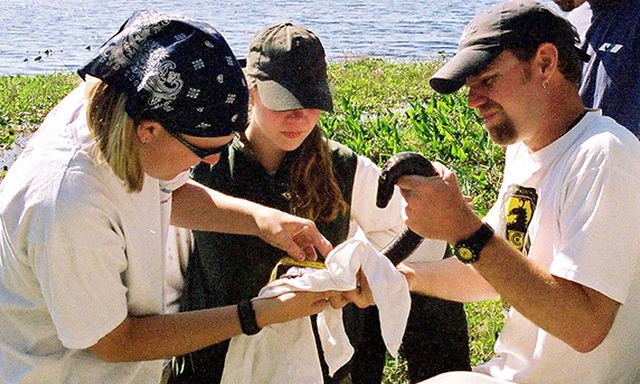Have you ever been fishing and caught what looked like a giant eel covered in slime? Well, you may have encountered one of Florida's native giant salamanders. These salamanders are plentiful in Florida, but are rarely seen because of their secretive nature. Besides researchers who study them, often the only people who glimpse these amazing creatures are fortunate fishermen. Seeing these giant salamanders may at first be frightening, but have no fear—they are harmless to humans and quite fascinating!
Description
There are two species of large, aquatic salamanders in Florida:
-
Two-toed Amphiuma (Amphiuma means)
and
-
Greater Siren (Siren lacertina)
Both of these giant salamanders are often confused with eels. In fact, you may hear people call these salamanders "mud-eels" or "ditch-eels." However, eels are a type of fish with obvious fins running along their back and underside. Salamanders are amphibians. Amphibians have limbs and no fins. Also, giant salamanders are easily distinguished from aquatic snakes because their skin is smooth, slimy, and lacks scales.
Greater sirens (Siren lacertina) average between 1 and 2 feet in length, while Two-toed amphiumas (Amphiuma means) can grow to lengths of 3 feet or more—one of the largest salamander species in the world. Both of these salamanders have an elongated body shape with reduced or absent limbs. Two-toed amphiumas have tiny, nearly useless front and hind legs with two toes on each leg (Figure 1). Greater sirens have more robust front limbs with four toes, but have no hind limbs (Figure 2).

Credit: Kristina Sorensen

Credit: Kristina Sorensen
Both species are dark gray in appearance, but Greater sirens sometimes have black or gold flecking on their backs. Greater sirens have bushy, external gills, whereas Two-toed amphiumas have a single gill slit on each side and no exterior gills. There is no way to externally determine the sex of either species.
Distribution and Habitat
Two-toed amphiumas and Greater sirens occur along the Southeastern coastal plain from Alabama to Virginia, and throughout Florida. They use a wide array of habitats including lowland swamps, lakes, rivers, ditches, etc. They are frequently found in or near mucky and/or heavily vegetated areas. They are probably found in your backyard pond or community lake. Few formal population studies have been done on these species, but it is thought that they may be very abundant in areas where they occur.
Behavior and Diet
These salamanders are primarily nocturnal, which means they are most active at night. Using just a flashlight at night, one may observe Greater sirens foraging under water or see Two-toed amphiumas surfacing to breathe. However, these animals are highly secretive so most people will never encounter them. Very little is known about aspects of their behavior such as activity patterns, dispersal, and home ranges. Both species are generally harmless to humans and should not be feared.
Giant salamanders primarily eat aquatic insects, worms, crayfish, mollusks, and small fish. If you catch one on a fishing hook, use a cloth rag to grab it behind the head and remove the hook. These giant salamanders are extremely slimy and will slip easily through your hands if you don't use a cloth rag or gloves.
Reproduction
Unfortunately, dissection is the only known way to tell the difference between males and females of these species. Very little is known about how giant salamanders reproduce. Both of these species lay eggs, but only a few nests have been found in nature. In amphiumas, fertilization of eggs is internal (similar to humans), meaning their eggs are fertilized within the female's body before she lays them. However, in sirens fertilization is believed to be external (similar to most fish), meaning the female lays unfertilized eggs and then they are fertilized by a male. Very little is known about juvenile animals of these species. More long-term study is needed in this area.
Ecology
Two-toed amphiumas and Greater sirens are important members of the food chain as both predators and prey. They can achieve high population densities in an area and serve as an important food source for wading birds, aquatic snakes and alligators.
These salamanders spend much of their time buried in muck or in underground burrows near water. They are able to survive long periods of drought by building a cocoon and aestivating. Aestivation is a behavior in which an animal goes dormant for an extended length of time (similar to a bear hibernating when it's cold). During aestivation, these salamanders slow down their metabolism and live off of large fat reserves located in their tails. This adaptation allows them to live in both permanent and temporary bodies of water.
Research and Conservation
Undoubtedly, these two giant salamander species are being affected by the large-scale loss of wetlands in the southeastern United States. However, it is impossible to determine the effects on the numbers of amphiumas and sirens because no long-term population studies have been conducted on either species. In other words, changes in current numbers of giant salamanders cannot be understood because we do not have information about past populations that could be used for comparison. To determine the impact of habitat loss on these poorly understood species, more study is needed (Figure 3). Currently, neither species is listed as threatened or endangered within the extent of its range.

Credit: Steven McAlpin
Although these salamanders have been around for thousands of years, we know relatively little about them. More research needs to be conducted so we can answer fundamental questions about their biology. Currently, there are only a few scientists researching Two-toed amphiumas and Greater sirens. Perhaps in the future, the work of these scientists will inspire further research.
Selected References
Ashton, R.E. and P.S. Ashton. 1988. Handbook of Reptiles and Amphibians of Florida. Part Three: The Amphibians. Miami, FL: Windward Publishing.
Behler, J.L and F. W King. 1979. National Audubon Society Field Guide to North American Reptiles and Amphibians. New York, NY: Alfred A. Knopf.
Conant, R. and J.T. Collins. 1998. A Field Guide to Reptiles and Amphibians. Boston, MA: Houghton Mifflin Companyy.
Petranka, J.W. 1998. Salamanders of the United States and Canada. Washington, DC: Smithsonian Institution Pres.
Ultsch, G.R. 1973. "Observations on the life history of Siren lacertina." Herpetologica 29(4): 304–305.
Weber, J.A. 1944. "Observations on the life history of Amphiuma means." Copeia 1944(1): 61–62.